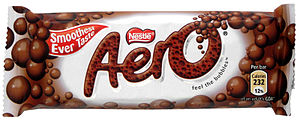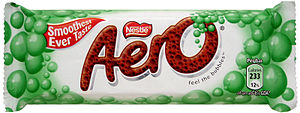- Aero (chocolate)
-
Aero is a milk chocolate bar filled with bubbles of air, made by Nestlé and primarily sold in the United Kingdom (where it originated), the Republic of Ireland, South Africa, Argentina, Australia, Middle East and Canada.
Contents
History
The process of manufacture was patented in 1935 by Rowntree's.[1][2] Registration of the trademark and manufacture to market started soon after.[citation needed]
There are several flavours of Aero. These include the Original Aero (which consists of milk chocolate throughout), Mint Aero (with a green bubbly mint-flavour centre covered in milk chocolate), Caramel Aero (with a caramel layer on top of the chocolate layer), Dark Chocolate Aero, White Chocolate Aero, Latte flavour Aero and Crispy Aeros (similar to Nestlé Crunch bars). Orange Aeros (orange/chocolate layered) were sold for a while as well, and larger 100g sized bars are currently available in some stores. In the 1970s there were also Strawberry flavour bars. In the UK, and recently Canada, Aero Bubbles are also available. These are small, round chocolates with a bubbly centre, available in Milk Chocolate and Mint flavours and a mixture of both.
Japan has produced dozens of unique Aero flavours, among them Vanilla Milkshake, Hot Milk, Green Tea and others. They usually consist of a flavoured, coloured chocolate centre and outer milk chocolate layer. Aero Cocoa (plain, Green Tea and Strawberry flavours) is also sold in Japan. Released in 2006, the Aero Vanilla Yoghurt flavour was released only in Canada. As with all other Aero bars manufactured by Nestlé in Canada and Nicaragua, it is manufactured in a peanut-free facility. In Australia there is also an Aero Temptations bar, which has the bubbly chocolate, but with a caramel topping. In Ireland there was an Irish Cream flavour Aero.[citation needed]
In 2010 in the UK, Nestlé modified the ingredients and colouring of the Mint Aero Bubbles product. This resulted in the product retaining its mint flavour, but losing its distinctive green bubble interior. This has been explained by Nestlé as being a response to corporate policy to remove food colourings from the product. There has, however, been no indication that the Mint Aero chocolate bar is to be modified in the same way.
Countries where the Aero bar is sold
As well as the United Kingdom, its place of creation, the bar is also sold as Aero in Argentina, Australia, Bahrain, Bulgaria, Canada, Colombia, Croatia, the Czech Republic, Estonia, Germany, Hong Kong, India, Nicaragua, the Republic of Ireland, Kuwait, Malta, Mauritius, Portugal, Poland, Serbia, Slovakia, Spain, New Zealand, Japan, South Africa, Ukraine, Saudi Arabia, South Korea and the United Arab Emirates.[citation needed]
In Brazil the bar is known as Suflair. In Hungary it is sold by Nestlé as Boci Aero and in the Netherlands it is sold by Nestlé as Bros (meaning "brittle"). Aero enjoys a large market following in South Africa with Aero, Aero Mint, and recently White Aero and Cappuccino Aero.
The Aero bar was made available for a short time in the United States by Nestlé during the 1980s, though it seems not to have been a commercial success. However, they are still available at certain speciality vendors or supermarkets such as Big Y and Wegmans that import the bars. Previously The Hershey Company sold Aero bars in the United States under licence from Rowntree Chocolate Company from 1937 until 1939. Another place to find them is in the United Kingdom section of the World Showcase at Epcot, Disney World, as well as the international food aisle in Kroger, Fresh and Easy, Meijer and some Publix locations nation-wide.
Manufacture
Aero bars are manufactured in nut-free services. They are made in a number of discrete stages beginning with deposition of unaerated shell chocolate into the bar moulds. A frozen cone shaped to fit into the bar is then pushed down to spread the liquid chocolate into the entire mould and set it. The aerated chocolate is then deposited into the centre and the moulds are shaken to distribute the chocolate evenly in the cavity. This is then chilled to set the bubbly chocolate in place before a final backing off deposit is created to give the back. The moulds are then shaken again to get a flat even back. The moulds are specially shaped to ensure that no meniscus is formed on the bottom, which can give the chocolate a scuffed appearance and also cause issues with the machines when they break off and build up. The bars are then chilled again for a longer period. This helps to make the chocolate contract for easier demoulding. The moulds are then tipped over and hammered to demould the bars, which then go to the packaging section.
Slogans
The slogan for Aero in Australia during the 1980s was "It's the bubbles of nothing that make it really something." From the 1999 redesign and "singers" advertising campaign Aero's tagline was "Have you felt the bubbles melt?" This slogan was invented by Nick Welch, an advertiser and the father of Florence Welch of the indie band Florence and the Machine. The latest slogan as of 2011 is now "Irresistabubble". In 2012 the Aero bar slogan will be changed to "Get your bubble on".[citation needed]
Marketing and advertising
One commercial involves two women buying the bar from a convenience store and one of the women instructing the other to wait for the bubbles to melt. They both try it and remark to one another (their mouths still full of the chocolate), "You feel the bubbles?" "I love the bubbles".
More recently an advert featured American actor Jason Lewis in just a towel explaining how chocolate melts at 37.0 °C (98.6 °F) (body temperature) and that as the bubbles melt it "increases the pleasure...".
A recent commercial from Aero was shot by Ty Evans and Wayne Daly, featuring skateboarder Bob Burnquist; it consisted of skateboarding through a skate park full of balloons. This advert has become very popular due to its entertainment value and its lack of "gender branding".[citation needed] The song used in this advert is Jackson 5's "ABC" song.
Aero conducted a six week roadshow to promote their Aero Hot Chocolate product. This experiential marketing campaign was exclusive to Asda stores and included 45 activity days. It proved very successful winning the ISP (Institute of Sales Promotion) Gold award for Experiential Marketing at Point of Purchase 2009. The key success criteria for this campaign was a product sampling rate in excess of the original forecast of 150k—throughout the six week roadshow; 179,450 samples were taken with a sample to product conversion rate of 64%.[3]
See also
References
- ^ GB 459582, Todd, John William & Rowntree & Co. Ltd, "Improvements in and relating to manufactured articles of food or confectionery", published 11 January 1937, issued July 11, 1935
- ^ GB 459583, Todd, John William & Rowntree & Co. Ltd, "Improved process for manufacturing articles of food or confectionery", published 11 January 1937, issued July 11, 1935
- ^ "Aero Experiential Marketing Results". iD Experiential. http://www.idexperiential.co.uk/Clients/Aero-Hot-Chocolate.
External links
- Aero to share
- A Brief History Of Aero (letter from Nestlé UK)
- Nestlé Aero Bubbles
- Aero "hunk" advert
Categories:- Candy bars
- Nestlé brands
- Products introduced in 1935
- Canadian snack foods
- Rowntree's brands
- Yorkshire cuisine
Wikimedia Foundation. 2010.





